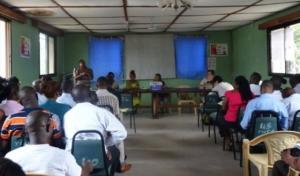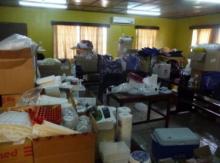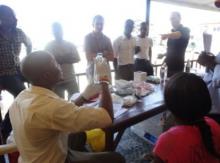Preparations to conduct National Micronutrients Survey
Background
Micronutrient deficiencies are a common public health challenge affecting all age groups in developing countries. It may lead to adverse health consequences as well as infant and maternal mortality.
The Ministry of Health and Sanitation in collaboration with UN agencies (UNICEF, WHO, FAO and WFP), Helen Keller International (HKI) and other partners in nutrition have conducted the first national Micronutrient survey in Sierra Leone. Technical support for the survey was provided by the WHO with funding from CIDA through the Accelerating Nutrition Improvements (ANI) project. The target groups for the survey were children aged 6-59 months and women of reproductive age (15 – 49 years).
Why Micronutrient Survey?
Nutritional deficiencies are posited to be one of the leading causes or mortality and morbidity in Sierra Leone. However, national data on micronutrient status (vitamin A, folate and vitamin B12, iodine) are largely missing or out- dated (iodine). There is therefore need for evidence based data on the micronutrient status of women and children. The survey is an opportunity to update and provide accurateinformation to guide decision-making and programme design to improve micronutrient status. Furthermore it will serve as a baseline for key indicators in the National Food and Nutrition Security Implementation Plan. At a more detailed level, the survey is expected to inform the development of an integrated action plan for the control of micronutrient deficiencies.
Survey Objectives
The general objective of the national micronutrient survey was to determine the prevalence and severity of selected micronutrient deficiencies (Vitamin A, iron, folate, Vitamin B12 and Iodine deficiencies) and associated factors among women of reproductive age and young children.
The specific objectives of the survey were:
- To determine prevalence and severity of anemia, iron, vitamin A, folate, vitamin B12 deficiencies among children age 6 – 59 months and women of reproductive age (15–49 years)
- To determine the prevalence of iodine deficiency among women of reproductive age (pregnant and non- pregnant women)
- To estimate household coverage with adequately iodized salt
- To determine malaria prevalence
- Survey Methodology
A total of 1,440 households were selected using cross-sectional stratified sampling method. Two strata (representation of urban and rural areas) were selected. Within each stratum, 30 Enumeration areas (EAs) were selected with their selection probability being proportionate to population size. Also, within each EA, 24 households were randomly selected from a prepared and up-to date household list. A total of 60 clusters were selected from the two strata (2 strata x 30 clusters), leading to an overall total sample size of 1,440 households.
Survey implementation
Training of survey teams and field testing of survey procedures
Five days training was conducted for survey teams and facilitated by GroundWork consultancy firm. The training was used to familiarize survey teams on survey procedures, instruments and equipment. The training took the form of presentations, discussions, group work, role play and demonstrations. Field testing of survey procedures formed an integral part of the training.
Selection of team members
Recruitment of survey teams for data collection was based on performance. From the pool of trainees, selection of teams was done using a post-test and practical sessions (field testing).
Data collection
Data collection took place in November - December 2013 with eight teams involved in the process. Each team comprised of a team leader, phlebotomist and interviewers. Lab technicians were also trained and recruited for the survey. Four laboratories, one in each region (Western, Southern, Northern and Eastern) of the country and two satellites laboratories were in operation for the whole survey period for the collection and storage of samples to ensure that quality was maintained.
Next steps
- Quantitative analysis of samples collected from households
- Double data entry of questionnaire data by HKI
- Centralization, sorting, and shipment of plasma samples to international laboratories.
- Data analysis and report writing by Groundwor





